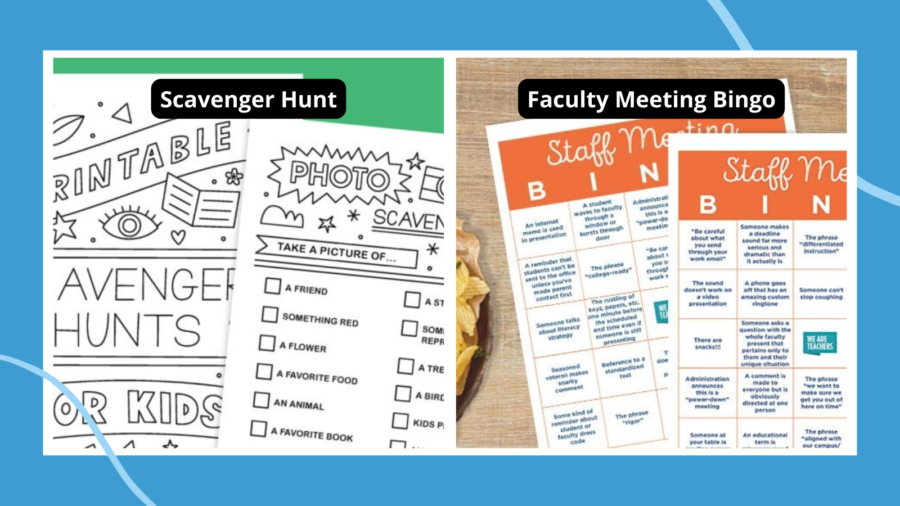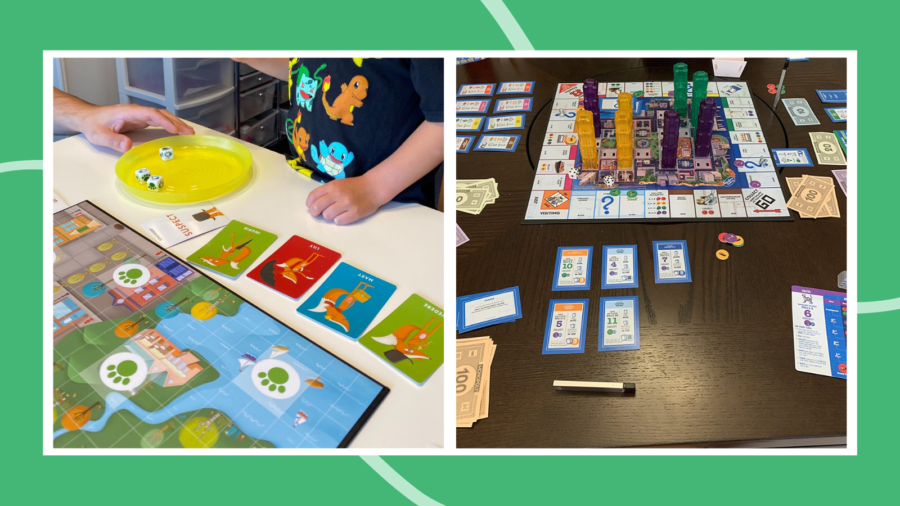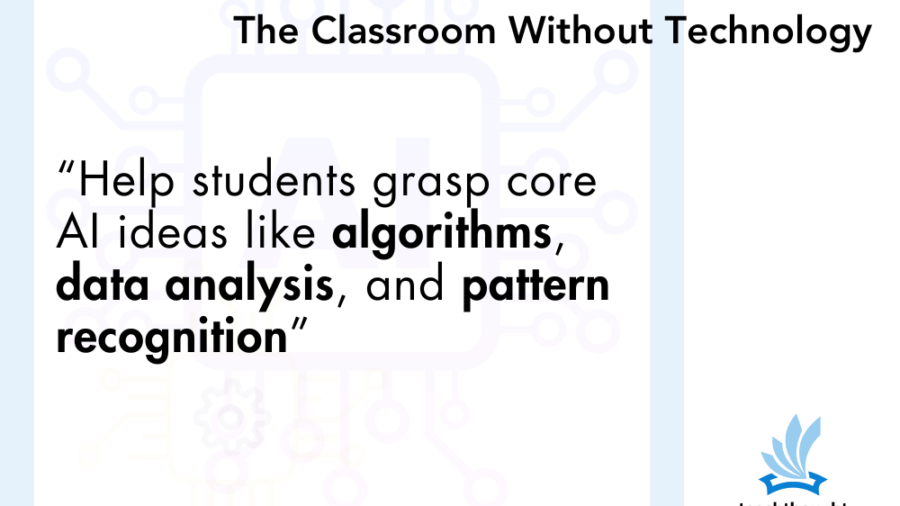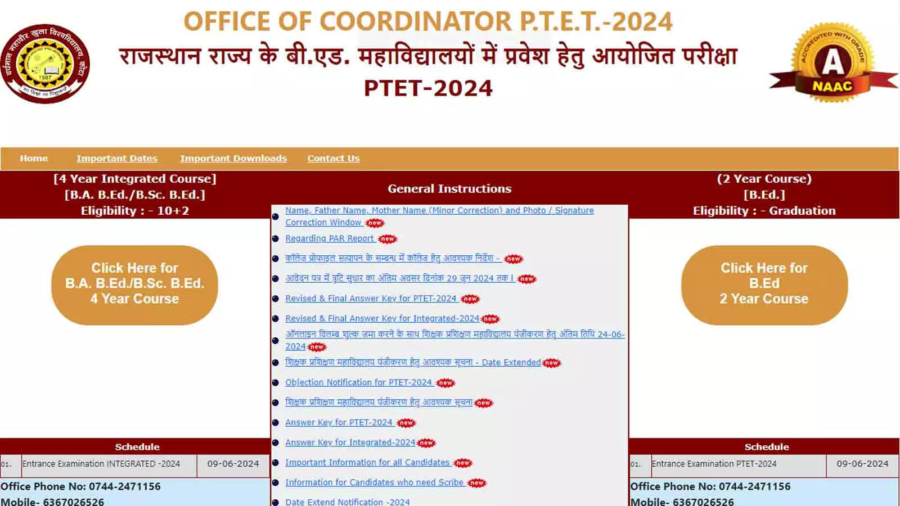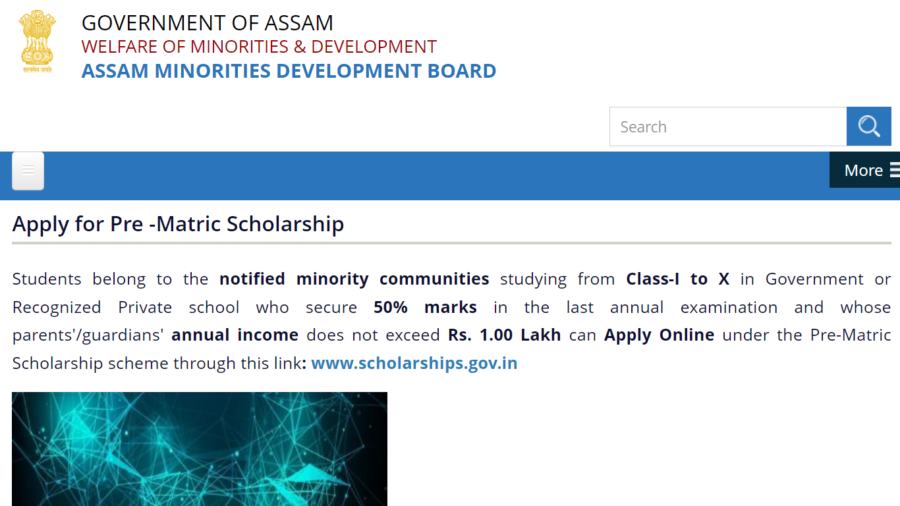Build a sense of cooperation and camaraderie.Build a sense of cooperation and camaraderie.
41 Best Board Games and Other Games for Kids, According to Teachers
For indoor recess, centers, skill building, and fun!For indoor recess, centers, skill building, and fun!
How To Teach Artificial Intelligence In The Classroom Without Technology
Strategies for Teaching AI Concepts Without Technology
by TeachThought Staff
Preface: This post is primarily for general content-area K-12 teachers (likely 6-12). Teaching AI theory, for example, is well beyond these ideas.
You don’t need a wind tunnel to learn about aerodynamics or boiling water to help students understand boiling points.
How you teach something depends, obviously, on what you’re teaching. Hands-on approaches can support creating compelling, engaging, and memorable learning experiences.
However, skills and ideas can be introduced, practiced, mastered, or reviewed anytime.
For example, it’s possible to introduce students to AI concepts without relying on technology.
You don’t need a wind tunnel to learn about aerodynamics or boiling water to help students understand boiling points.
By using teaching with analogies, discussions, and hands-on activities, students can begin to understand AI in an engaging and accessible way.
Let’s take a look.
Introducing AI in the Classroom Through Creative, Hands-on Methods
1. Understanding AI Concepts
Start by helping students grasp core AI ideas like algorithms, data analysis, and pattern recognition through traditional teaching methods
Analogies and Stories: Compare an algorithm to a recipe a chef follows, highlighting the step-by-step process. Use stories to explain AI, such as likening it to a detective solving a mystery by piecing together clues.
Discussions and Debates: To encourage critical thinking, engage students in conversations about AI ethics, societal impacts, and future possibilities. Use case studies of AI origins or advancements to help them make broader sense of AI as both a tool and a product or symbol of technological progress.
Compare an algorithm to a recipe a chef follows, highlighting the step-by-step process. Use stories to explain AI, such as likening it to a detective solving a mystery by piecing together clues.
Concept Mapping: Have students create visual maps connecting different AI terms and ideas to help them see how various aspects of AI interrelate.
AI in Everyday Life: Introduce an ‘AI Diary’ project in which students log their interactions with AI-driven technologies for a week and discuss their observations in class.
See also 10 Roles For Artificial Intelligence In Education
2. Simulation and Role-Playing
Simulate AI processes with hands-on activities
Human Algorithms: Students can act as parts of an algorithm by sorting themselves by height or birth month. This helps them understand sorting processes.
Decision Trees: Create exercises where students make decisions based on set criteria, mimicking how AI makes choices.
Pattern Recognition: Engage students in activities that require them to recognize patterns, such as trends in historical events or sequences of numbers.
Physical Computing Simulation: Design and ‘program’ cardboard robots to perform simple tasks, introducing concepts of sensors and actuators.
Design and ‘program’ cardboard robots to perform simple tasks, introducing concepts of sensors and actuators.
3. Data Collection and Analysis
Teach the importance of data in AI through manual data collection
Surveys and Experiments: Conduct surveys or experiments and analyze the data to identify patterns and make predictions.
Math Integration: Use math lessons to teach statistics and probability, linking these concepts to how AI processes data.
Historical Data Analysis: Analyze historical data to identify trends and demonstrate how AI forecasts future events.
Data Visualization: Create visual representations of data to help identify patterns and make predictions, similar to AI systems.
4. Problem-Solving Activities
Encourage logical thinking and problem-solving skills essential for AI
Logic Puzzles and Games: Introduce puzzles and games that require logical thinking and pattern recognition, such as Sudoku or chess.
Creative Challenges: Set challenges requiring innovative problem-solving, like building a structure with limited resources.
Algorithm Design: Have students create algorithms for simple tasks, such as organizing chores or scheduling events.
Computational Thinking Exercises: Create step-by-step instructions for tasks, teaching abstraction and problem decomposition.
Have students create algorithms for simple tasks, such as organizing chores or scheduling events.
5. Critical Thinking and Ethics
Explore AI’s ethical dimensions through case studies and debates
Case Studies: Discuss real-world AI applications and their societal impacts.
Ethical Debates: Debate AI-related ethical issues like privacy and job displacement.
Philosophical Questions: Pose questions like ‘Can a machine be truly intelligent?’ to encourage deep thinking.
Future of Work Discussions: Research how AI impacts careers and discuss societal adaptations to technological changes.
6. Cross-Disciplinary Projects
Incorporate AI concepts into other subjects
Literature and AI: Read and analyze stories exploring AI themes, like ‘Frankenstein’ or ‘I, Robot.’
History and AI: Study the history of technological advancements and their societal impacts.
Art and AI: Create artworks inspired by AI-generated pieces and discuss AI in digital art.
Science and AI: Explore AI applications in scientific research, such as analyzing astronomical data.
Music and AI: Discuss AI-generated music and its implications for creativity and the future of music composition.
Science and AI: Explore AI applications in scientific research, such as analyzing astronomical data.
7. Reflective Writing
Encourage students to reflect on their learning
Journals and Essays: Keep journals or write essays on AI concepts and future predictions.
Peer Reviews: Foster collaborative learning through peer reviews of reflections and essays.
Future Scenarios: Write scenarios of future daily life with advanced AI technology.
Collaborative AI Stories: Write short stories about AI’s impact on various societal areas in groups.
8. AI-Inspired Teaching Methods
Enhance teaching methods by drawing inspiration from AI
Personalized Learning Paths: Allow students to choose different routes through topics based on interests and prior knowledge.
Adaptive Assessments: Design quizzes that adjust difficulty based on student performance.
Flipped Classroom Approach: Use class time for personalized support and advanced discussions after students engage with content beforehand.
The post How To Teach Artificial Intelligence In The Classroom Without Technology appeared first on TeachThought.
Actual access to Artificial Intelligence in the classroom only requires a web browser but what about teaching AI without technology?
The post How To Teach Artificial Intelligence In The Classroom Without Technology appeared first on TeachThought.
TNEA 2024 counselling registration begins tomorrow at tneaonline.org: Check complete schedule and other details here
DoTE Tamil Nadu starts TNEA 2024 online counselling on July 22. Registered candidates can view the schedule on tneaonline.org. Comprising three rounds, the process includes choice filling, allotment, confirmation, and fee payment stages. Key dates: July 10 rank list, July 22-27 (special), July 29-Sept 3 (general), Sept 6-8 (supplementary), Sept 10-11 (SCA to SC).
WB Primary TET Result date 2024: WBBPE TET Scorecard out soon, check qualifying marks and other details
WB Primary TET Result 2024: The West Bengal Board of Primary Education (WBBPE) is set to announce the WB TET results soon. Candidates who appeared for the exam on December 24, 2023, can check their scorecards on wbbpe.org. Enter registration number and DOB to view and download the WB TET Result & Score Card 2024.
Rajasthan PTET Counselling 2024: College Allotment List released, direct link to check here
Rajasthan PTET Counselling 2024: VMOU Kota releases first PTET College Allotment List. Check seat results at ptetvmou2024.com. Allotted candidates must pay Rs. 22,000 by July 25, 2024, via e-Mitra or ICICI Bank. Download allotment letters from the website. Details sent via SMS. Refunds for non-allottees; next exam option available.
Assam pre, post-matric scholarship registration begins: Check eligibility, direct link and steps to apply
Assam Tribal Affairs opens 2024-25 scholarships for ST students. Eligible students should apply on scholarships.gov.in. Required are Aadhaar, income and caste certificates, and bank details. An OTR number, acquired via face-authentication, is essential. Scholarships cover Classes 9-10, higher secondary schools, colleges, and universities. Income cap: Rs 2.50 lakh. Pre-matric deadline: August 31; post-matric: October 31, 2024.
Who is Manoj Soni: UPSC chairman who resigned 5 years before completion of tenure for ‘spiritual calling’
UPSC Chairman Manoj Soni stepped down to engage in socio-religious work with Anoopam Mission. Soni has a background with Dr. Babasaheb Ambedkar, The Maharaja Sayajirao Universities, and Sardar Patel University. A close PM Modi ally, Baton Rouge honoree, Soni joined UPSC in 2017, becoming Chairman in 2023.
Top 10 IT Courses to Boost Your Career in 2024
Introduction:
Whenever there is a new release in a particular field it becomes so important to master the new skills that come with the new releases. In case you are a new comer to the IT professional world or an experienced one, transforming the right IT course can enhance one’s career. Below are the 10 IT courses to consider in 2024.
Best IT courses 2024: Learn most demanded IT courses in this year range from programming to project management.
Online IT certification: Discover the advantages and the possibility of getting IT certifications through the Internet.
IT courses for beginners: Get to know the best entry points for the beginners in the IT sphere.
Cybersecurity certification: Learn the significance of cybersecurity and the right programs in security.
Data science courses: Who and what is data science? Help guide for choosing the best courses :
Machine learning courses: These courses give you an insight into the world of machine learning.
Cloud computing certification: Cite information concerning cloud computing, and the certifications that are useful in the course.
AI courses online: Learn how to master in artificial intelligence through online classes.
Network security courses: Improve your understanding in Network Security by taking these courses.
Web development bootcamp: Learn web development at a faster pace with bootcamps.
Conclusion:
Selecting the correct IT class can open up a huge difference in your occupation. Thus, it is advised to invest in your future by joining one of the best classes offered in these course areas and remain relevant in the fast-growing technology sector.

